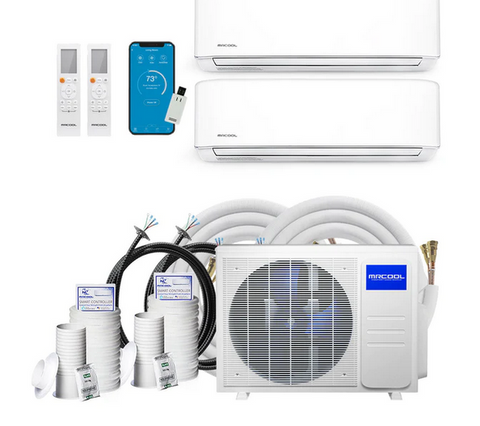Mini-splits are becoming more and more popular because they are a convenient way to add heating and cooling to any room, without the need for ductwork or major construction. But since mini-splits aren’t as common as the big air conditioner and furnace units we all grew up with, their components can be a bit of a mystery. If you’ve been wondering what condensers and air handlers do in these popular HVAC systems, you’re in the right place. As you’ll see, a mini-split is a straightforward, streamlined system to allow for greater flexibility when it comes to placement of climate control units.
What Is a Mini-Split System?

Before we jump into the specifics of condensers and air handlers, let’s clarify what a mini-split system is. A mini-split is a type of heating and cooling system that allows you to control the temperature in individual rooms or spaces. It’s composed of two main parts: an outdoor unit (condenser) and one or more indoor units (air handlers). If you’ve seen ads for “ductless air conditioning,” what they’re referring to is a mini-split. And if you’re wondering about the name “mini split,” well it comes from the fact that the compressor component and refrigerant are “split” and are located inside and outside the home.
What is a Mini-Split Condenser
The condenser is the box unit with the big fan that you’ll see attached to the side of a home. This part stays on the outside of the house and many times only one of these pieces is needed. However for heating and cooling larger areas (more rooms) you may need two or more additional condensers. The condenser’s job is quite important as it conducts the crucial process of heating or cooling a space. A mini-split condenser provides:
- Heat Dispersion: In cooling mode, the condenser expels heat removed from the indoor air into the outside environment.
- Refrigerant Cycle Management: It pumps refrigerant, which absorbs and releases heat, to and from the indoor units.
- Central Processing: The condenser houses the compressor, which is the component that prepares the refrigerant to perform its job effectively.
Think of the condenser as the central hub of activity for your mini-split system, handling the heavy lifting of temperature regulation.
What is a Mini-Split Air Handler
While the condenser is where air gets heated or cooled, this wouldn’t matter much if there wasn’t a way to push this climate-controlled air into the room's home. That’s where the air handler shines, acting like the distributor, taking the air that the condenser has conditioned and delivering it to your living spaces. Here are its roles:
- Air Distribution: The air handler blows the cooled or heated air into the room.
- Temperature Conversion: It houses the evaporator coil, where the refrigerant absorbs heat from the indoor air during cooling or releases heat during heating.
- Quiet Operation: Unlike traditional HVAC systems, the air handler operates quietly, making it ideal for bedrooms, offices, and other quiet spaces.
With a traditional air conditioning unit, ductwork would run throughout the home dispersing air throughout the home. But instead of ductwork, a mini-split set up relies on air handlers placed in each room to provide the influx of treated air. Air handlers can take on all shapes and placements, with some units designed to fit in the floor or ceiling. However, the configuration you’ll probably see the most is the wall mounted style air handler, which typically is installed close to the ceiling, providing an unobtrusive way to add heating and cooling to each room.
How Do an Air Handler and Condenser Work Together?
The condenser and air handler work together to keep you comfortable. In cooling mode, the condenser sends chilled refrigerant to the indoor air handler. The air handler then blows air over the cold coils, delivering cool air into your room. In heating mode, the process is reversed, with the refrigerant absorbing heat from the outdoor unit and releasing it inside.
Benefits of a Mini-Split System
- Individual Room Control: With separate air handlers in different rooms, you can control the temperature in each space independently. That means you don’t need to cool or heat unused rooms, which can offer a considerable savings on energy bills.
- Energy Efficiency: Mini-splits avoid the energy losses associated with ductwork, making them more efficient.
- Flexibility: Because they don’t require ducts, mini-splits can be installed in a variety of locations, including older homes and new additions, along with places where a traditional air conditioner unit simply won’t fit.
Your mini-split’s condenser and air handlers are the dynamic duo of your home’s comfort, working tirelessly to keep you cool in the summer and warm in the winter. Home Outlet Direct offers a wide variety of mini-splits, designed for any size house or room. With some of the most well-known and respected brands in the business, you’re sure to find one that will provide maximum comfort year round. Ready to say goodbye to those noisy window units that take up space and cost so much to run? Step into the future of home climate control with a new mini-split unit.



